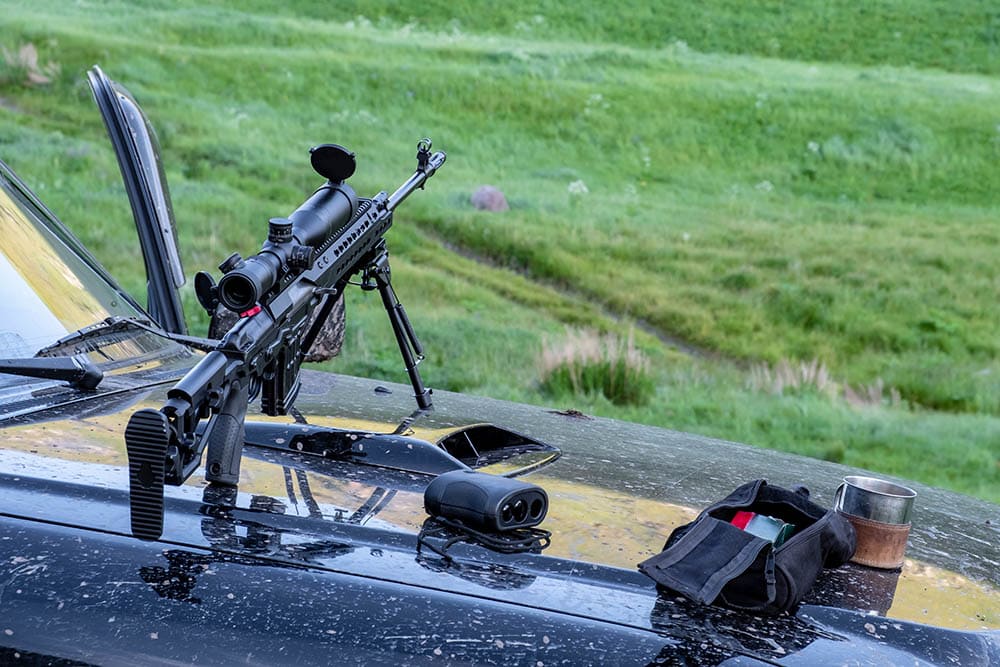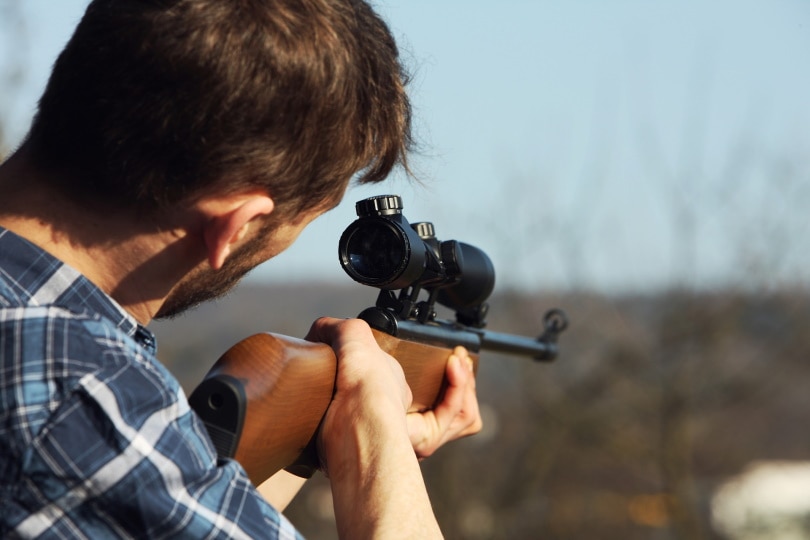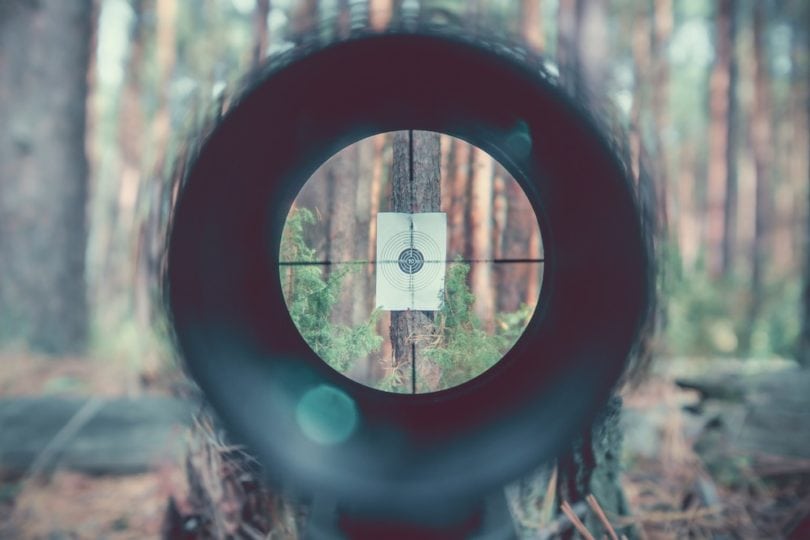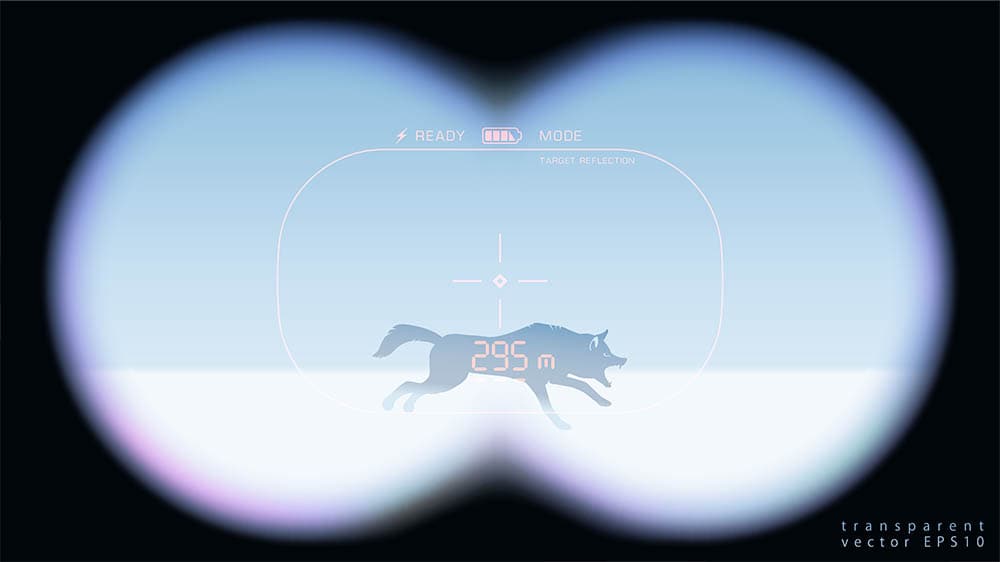How to Use a Rangefinder for Hunting: 5 Tips & Tricks
Last Updated on

If you’re an experienced hunter, you probably already know the importance of a rangefinder. Unfortunately, many hunters don’t include it in their kit, considering it a luxury item. However, a quality rangefinder makes a huge difference in making your hunt successful.
Like a spotting scope and binoculars, many classify a rangefinder as an essential tool in hunting. It ensures the accuracy of your shot from larger distances and is convenient to carry.
No matter how skilled or experienced a hunter you are, there is always a chance that you’ll miss a shot. After all, everyone makes mistakes due to poor judgment. There is no room for any mistakes when it comes to hunting—you either go home with something to show or empty-handed.
Let’s discuss everything about using a rangefinder for hunting in this guide.

How Does It Work?
Laser rangefinders work effectively in hunting. They help you hit your desired target at a distance with a laser while measuring the time taken for the laser to come back.
The laser’s speed and returning time estimates your target’s actual distance. Typically, rangefinders come with a maximum range for reflective targets.
How to Use a Hunting Rangefinder Properly
Your hunting rangefinder will make targeting a deer far away from your standing point easier. Not only that, but it also helps you determine the target’s distance. But how can you use this valuable tool the right way? Before going on your next hunt, keep these things in mind to make the most out of your hunting rangefinder.
1. Test the Scope of Your Rifle
One of the crucial things you’ve to do before using your rifle for hunting is checking its scope. You need to do a quick test to ensure that you’re appropriately sighted.
Put out a target in the distance the scope claims to reach and shoot it. Notice if the bullet hits right at the spot or not. If you experience jostling, you may get a not-so-perfect shot.
Using a variety of bullets may help you get a better idea of how things work out for you. Don’t forget to check your rifle’s night vision scope, especially if your hunting adventure will last till dark.

2. Aim Before a Target Shows Up
The biggest mistake hunters make while using rangefinders is waiting for the target to show up. It always takes a significant amount of time to find your rangefinder and set it up whenever a buck appears.
Keep your aim ready even before the target comes into your rangefinder’s range. Then, scan the entire area while standing on your tree stand or disguise.
This will help you determine your shooting lanes and distance to the set landmarks. Then, when a buck comes in your rifle’s range, you can instantly shoot it without wasting time finding your rangefinder.
3. Use Landmarks to Determine Distances
While using a rangefinder, marking the tees as landmarks will help you get a better idea of distances. You can use spray paint to make different symbols indicating different distances.
For example, one cross indicates ten yards; two crosses mean twenty yards, etc. This way, you won’t be confused between all the yardages and focus on shooting with your rangefinder properly.

4. Figure Out the Target’s Movements
Sometimes it’s impossible to stay proactive enough to aim at the target before it appears. In such cases, you need to figure out the animals’ movements. You would naturally pick up your rangefinder and aim it right at the animal, but this is not how it works.
Instead, put your rangefinder’s reticle where you think the animal will move the next second. Then, shoot at that “kill zone” as soon as you sense that animal is going to be on the move.
5. Benefit From the Holdover Calculator
Many hunters are comfortable shooting from a tree stand. While it’s completely okay, it usually has more chances of making misjudgments related to the distance. Since you’re at a steep angle, your mind may not process lengths as accurately as a level field.
Luckily, you’ll find a holdover calculator feature in your rangefinder. It determines the path that a bullet may take to hit the target, including the extra elevation required to fight gravity and your angle to the target. You may have to set the velocity of your shots to make the most out of the holdover calculator.

Is a Rangefinder Ideal for Hunting?
A rangefinder is a perfect choice for hunting. While it helps you hunt down prey at longer distances, it offers much more. Let’s go through the characteristics that make rangefinders ideal for hunting.
Offers Accuracy
A rangefinder is all about accuracy. It eliminates all the guesswork about missing a shot or a target. It reduces the distance between the hunter and the prey by killing the animal with a laser beam. This way, you don’t miss any target, and the animal doesn’t suffer from any wound or unnecessary pain.
Works Regardless of the Angles
Almost all rangefinders come with multiple angle compensation features that work irrespective of the ground level or angles. So, whether you’re hunting a zebra standing on level ground or a mountain goat walking on a hill, a rangefinder helps you take a calculated shot in both cases. However, you also have to adjust your scopes according to the rangefinder’s reading to make an informed shot.
Easy to Carry
While packing gears for a hunting adventure, fitting all of them in a bag always exhausts a hunter. Of course, every piece of equipment is important for you, so you can’t leave anyone behind.
The good news is that a rangefinder is quite convenient to carry. They have a compact size. Some are even smaller than a smartphone, weighing around half a pound. These tools have a vertical design, which means you can put and pull them out single-handedly.
You can carry almost any newer rangefinder around your neck on a lanyard. Alternatively, you can put it in a case or carry it in your coat’s front pocket.
Affordable
Laser rangefinders come in a wide price range. You can get a budget-friendly rangefinder from $100 to $250. However, paying a few dollars more is definitely worth it if you want to get better quality and functionality. If you want to make a one-time investment in rangefinder, you can even go for the one starting from $450 to $800.


What to Look for When Buying a Rangefinder?
Are you convinced enough to include a rangefinder in your gears? If so, don’t just go to the market and buy one. Instead, consider the below factors before purchasing a rangefinder to make the most out of your money.
Battery Life
It takes lots of effort and time to return from your hunting adventure with a full bag. What if you’re all motivated and excited, but your rangefinder’s battery drains in the middle? A nightmare, no?
Thus, check the battery life of a rangefinder. Although they already come with longer battery life, you can never know when they can run out. Of course, you can’t just carry two rangefinders. To stay on the safe side, you can take extra batteries as well.
Angle Compensation Feature
Angle compensation provides more accuracy to hunters. You won’t have to spend time guessing the landmarks, distances, and the target’s movements. Moreover, you can easily shoot at your target from steeper or angled grounds.
The angle compensation feature tells you the distance to the target. This helps a lot in ensuring the accuracy and efficiency of the shot. So, when buying a rangefinder, check if it has an angle compensation feature.
Water-resistance
You can never guess changes in weather. It can change anytime, leaving you clueless. Thus, get a rangefinder that can withstand the harshness of weather, whether wet, hot, dry, or cold.
Conclusion
Like with any hunting tool, a hunter needs to familiarize themselves with a rangefinder to ensure the accuracy of their shots. You can get several unique features in a quality rangefinder, starting from angle compensation, a holdover calculator to an efficient scope.
If you’re a passionate hunter who likes to take longer shots, invest in a rangefinder. Surely, it will allow you to enjoy your adventure to the fullest.
Featured Image Credit: Stocker plus, Shutterstock
About the Author Robert Sparks
Robert’s obsession with all things optical started early in life, when his optician father would bring home prototypes for Robert to play with. Nowadays, Robert is dedicated to helping others find the right optics for their needs. His hobbies include astronomy, astrophysics, and model building. Originally from Newark, NJ, he resides in Santa Fe, New Mexico, where the nighttime skies are filled with glittering stars.
Related Articles:
How to Collimate Binoculars: 9 Expert Tips
How to Clean a Rifle Scope: 8 Expert Tips
Can You Use Binoculars to Look At Stars? How to Choose the Right Pair
How to Choose Binoculars for Bird Watching: 10 Expert Tips
How to Clean a Refractor Telescope: Step-by-Step Guide
How to Clean a Telescope Eyepiece: Step-by-Step Guide
Monocular vs Telescope: Differences Explained (With Pictures)
What Is a Monocular Used For? 8 Common Functions
